structured conversations


conversations flow
“Human emotioning has its origin in the emotioning of mammals and primates, and because of that it admits the consensual modulation in the path of the coordinations of behavior outside as well as inside language; because of that, also, our emotional flow has spontaneous turns or changes that seem completely outside our history of conceptual living. At the same time, since every emotional change is a change in the domain of actions and, therefore, in the rational domain, due to our non-consensual emotional flow or due to our consensual emotional flow outside language, it results that often our discourse and our reasoning change in a manner that seems alien to us according to the path that a moment ago our conversation followed, and we find ourselves in an emotioning and reasoning that appear unexpected even after further reflection. An observer can describe such changes as a result of an emotional unconscious dynamics because they appear outside the consensuality of conversation and, therefore, outside the operationality of a consensual origin accessible to immediate reflection. In short, in our daily life the interbraiding of our emotioning with our living and co-living, be it consensual or nor, results in such a way that our emotioning follows a path which is contingent to our conversation as well as to the internal dynamics and to our interactions outside language, but which can, in general, be brought through reflection to conversing.”
1989 The Ontology of Conversing
talking stick
As the group size grows, the number of possible perspectives, and further the number of possible interpersonal relationships, increases geometrically.
Even in a group of only 6 people there are already 12 different interactions. In a group process, all of these come into play.


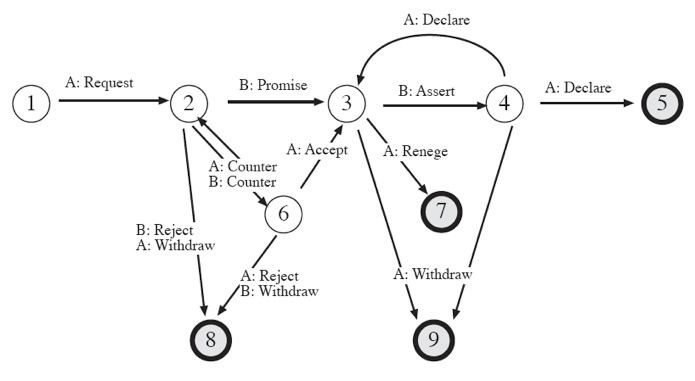
requests and promises
As a specific extension to the notion of speech acts, mentioned in Unit 8.1, Winograd and Flores developed a framework for the structure of requests and promises.
First a little about Flores. Fernando Flores had been imprisoned during the 1973 political coup in Chile, and Maturana had visited him there to continue with his teaching. Flores subsequently developed his own perspectives on the work, with particular attention to business applications. Flores was actually the person who introduced me to Maturana’s work as I attended his workshop on “Communication for Action” in the early 1980’s. I became enchanted by what I sensed as underlying this work, and as you know, I eventually had the opportunity to pursue it in depth.
There are some ideas from Flores’s workshop that remain with me, and one of these is the abstraction of the paths that requests and promises can take.
consensus
There are many ways of considering consensus. Unanimous decisions are not always easily come by. There is no need for a decision if everybody already agrees - the work can just proceed accordingly. If everyone does not agree, it may simply be a matter of clarification, or explanation of contingencies or other complications that are not visible to all the members of the group.
There are situations where unanimous decisions are not even desirable. For example it may be that a complex situation has been so oversimplified that important considerations are not taken into account, or that the group as a whole has been misinformed or misled. For example ancient Hebrew law considered a unanimous court ruling as potential evidence of corruption, and did not accept such judgements.
opening space
You are already familiar with using Open Space as a meeting process that promotes the free flow of conversation about any topic that a participant may propose, so I won’t describe it here. I do wish to acknowledge it as process that offers promotes a free flow of conversation according to the interests of the participants.
Another similar process is World Café which explicitly uses the metaphor of sitting and talking in a café where people feel at ease. World Café was co-developed by David Isaaks and Juanita Brown, who subsequently wrote a PhD thesis on this approach, incorporating Maturana’s ideas on conversation into the framework..
procedures, or “frameworks” can create space
I would like to refer to Maturana’s observation that whatever we begin to conserve creates space for everything else to change around that. This also applies to conserving a procedure. For example I can conserve the procedure of “boiling” and vary what it is that I boil from water to potatoes to instruments being sterilized. Thus also a framework for a meeting serves as a process, or metaphorically, a “container” while leaving the matter to be discussed open to changes. However, not all frameworks are equal in what they do conserve; and many conversation frameworks conserve premises about hierarchy and privilege.
There are two approaches to equalizing the communication flow; one is to minimize the rigidity of the framework, and the other is to develop one that ensures and organizes participation. Of the latter, the best system I know of is Syntegration, or Team Syntegrity.
dinner table conversations
In most situations we do not need a structure to manage the flow of our conversations. What is remarkable is how easily we do follow a conversation through all its twists and turns, sometimes in a group that keeps half a dozen separate strands or ideas going; each one potentially altering the others, while each remains coherent within itself. This shows particularly in informal groups where people are comfortable with and enjoy each other’s company - hence we refer to such conversations as “dinner table” or “café” conversations.
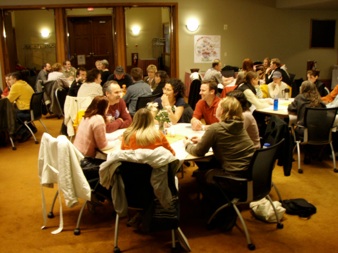
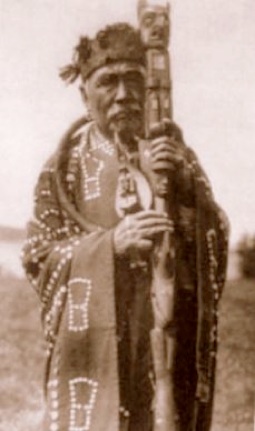
Wikimeia Commons:
A Kwakwaka'wakw man with a talking stick,
photo by Edward S. Curtis
endorsement
minor difference
agreement with reservations
formal
disagreement
block

Peoples throughout the ages have developed various structures to create an easier flow of conversation and interaction within a group. The oldest method that I am aware of is the “talking stick” or something similar, that determines who is currently the speaker, and should not be interrupted. Of course, status accrued to these sticks as some members of the group were endorsed to have more authority than others ... hopefully wise elders who acted in the interests of the well being of the group and its members from a long term perspective and a systemic understanding of both people and context.
Nowadays we have many formalized structures, from simple debates to corporate, legal, political and military conventions for conversations. As our context has grown, and as “leadership” is promoted as a social value, the care of the individual and the well being of the group is sometimes co-opted to serve the wellbeing of the decision making body.
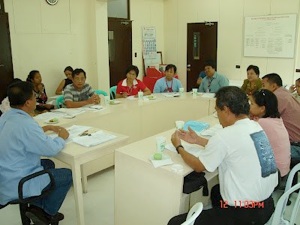
creative commons Research Meeting
pkdeviance.blogspot.co.uk
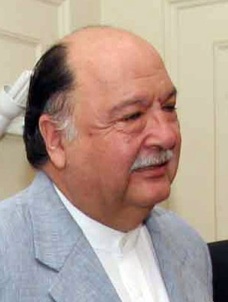
wikimedia commons
The diagram shows the various paths that a request made by A to B could flow. For me the most useful part of this presentation was an aspect that is not in the figure, namely the need for a discussion between A and B on what the criteria of satisfaction for having fulfilled the request entail. In other words, Flores illustrated the value of clarity concerning what constitutes completion of the request under discussion, inclusive of when it should be finished. I think I had been somewhat unaware prior to encountering this model about the “when” aspect ...
Flores went on do develop an early software program called “The Coordinator” which was intended to track the requests and promises made in an organization. This never became very popular, and I think for good reasons. Namely though the framework serves as a illuminating abstraction, it becomes onerous if treated as a formula. Rather than offering insight, it becomes a demand.
syntegration
The process of syntegration was developed by Stafford Beer, a cybernetician. The appended optional reading is coauthored by my friend Allenna Leonard, who is also a cybernetician and is Beer’s widow.
The original version was designed on the basis of an icosahedron, pictured above. It is designed to enable the equal participation of 30 people (the bicolored struts) in discussions concerning a complex idea or “opening questions” that these same participants elucidate and then group into 12 subtopics (the nodes). Each person has a primary role with two topics, and a critic role with two others. Further, they are in an observer role with yet another two topics. The octahedron form is intended for smaller groups; a dozen people discussing a complex idea divided into 6 different topics.
The way a series of meetings, ideally over three days, are organized around this framework ensures that not only does everybody have an equal voice, but also that there is an excellent flow of information among the people and the topics. Further, when a syntegration meeting is delivered by trained facilitators, all the content is synthesized and presented back to the group in real time.
The process is very useful in both exploring possibilities and developing an action plan for a group. We used it in the first stages of conceiving and developing the SD Graduate Institute.
watch a short animation under “Discover the Syntegration Process”
click on drawing for link to World Café website



In most circumstances that are complex enough to require a group discussion it is useful to consider degrees of consensus. Once all rationales for and against a particular choice are clarified, each group member can specify how strongly they agree or disagree. As shown in the continuum below, in one model of “degrees of consensus” there are four degrees of agreement that enable a project to go ahead, and only one degree that prevents the go ahead. Group members would normally use the “block” judiciously, that is only when they believe the situation truly warrants a strong stance.


